Symbolic use of animals, status, belief systems by Katerina Trantalidou
C. Doumas - An. Devetzi (eds.), A k r o t i r i , T h e r a, F o rt y y e a r s o f r e s e a r c h ( 1 9 6 7 - 2 0 0 7 ) , 2021
Presented here are the data that have emerged from examination of the deposit of horns, which was... more Presented here are the data that have emerged from examination of the deposit of horns, which was excavated south of Xeste 3. In order to understand the biological provenance of the material and the cultural choices of the people, scientific data from the deposit, such as the species of animals, the percentage ratios of animal species, the Minimum Number of Individuals, the sex or the osteometry, are correlated with the rest of the archaeozoological sample recovered from the LC I settlement at Akrotiri, as well as from 63 sites in the eastern Mediterranean
Archaeologikon Deltion 69-70 (2014-15), 2018
A N O D O S Studies of the Ancient World 6-7/2006-2007, 2008
K. Trantalidou, T. Theodoropoulou. Animal offerings in the sanctuary of Vryokastro on Kythnos. In A. Mazarakis-Ainian (ed.), Les sanctuaires archaïques des Cyclades, Presses Universitaires de Rennes, Rennes, 2017, 257-273
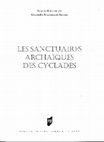
Dans cet article, les auteurs se proposent d’examiner le matériel archéozoologique issue de... more Dans cet article, les auteurs se proposent d’examiner le matériel archéozoologique issue des fouilles des années 2002-2006 sur le plateau médian de la cité antique de Kythnos. La terrasse aménagée sur les pentes de la ville Haute comporta un double oikos, ses couloirs annexes Γ et Δ et ses murs de soubassement, deux autels perpendiculaires à l’édifice subventionné et un dépotoir votif « apothètes ». L'ensemble architectural fut délimité par un mur de fortification qui fonctionna comme le péribole du temenos. L’oikos fut consacré aux divinités olympiennes, probablement Apollon et Artémis (voir le chapitre sur la topographie du sanctuaire).
Les documents archéozoologiques, à savoir les 50,000 environ fragments d’os et des coquilles sont, pour la plupart, les restes des pratiques rituels et des événements festifs qui se sont déroulés du VII / VIe siècle au Ie siècle av. J.-C. Les auteurs du texte se sont permis de s’interroger sur certains aspects des rites en se concentrant sur le contexte archéologique, les indices spatiales et temporaires, les espèces animales, la taphonomie et la topologie du corps des animaux domestiques (habituels) et du gibier.
La répartition spatiale révéla que le plus grand nombre des ossements fut concentré autour des autels et dans le dépôt votif. En revanche, les coquillages et les autres matériaux marins furent plus nombreux dans le sékos de l’oikos du sud, dont les sédiments étaient restés intacts, datant du début du VIIe siècle.
La majorité des débris originaires des autels datent de la période hellénistique, la dernière période de l’usage du temenos, mais le dépôt votif, adossé au mur de l’enceinte, comprenait des offrandes écartées d’âge archaïque et classique.
L’examen taphonomique macroscopique du matériel osseux a permis d’évaluer une importante fragmentation et une combustion prolongée des os qui proviennent des couches noircies et grisâtres. La majorité des ossements, provenant du dépôt votif était calcinée, voire craquelés. Dans l’ensemble du temenos, 1% du matériel est resté en entier. En somme, les vestiges représentent divers faits religieux:
1. Dépôts votifs à l’intérieur du sékos. Les offrandes faites à la divinité en demande d'une grâce ou en remerciement d'une grâce obtenue furent multiples (voir le chapitre des petits objets). Parmi eux, 41 astragales (18 provenant de chèvres et 13 de moutons) dont un était aplani et 1735 fragments de coquillages (Tables 1, 3).
2. Dépôts de fondation du temple. Objets votifs et ossements calcinés (Table 1) témoignent que l’opération a été faite au moment du réparation du temple au IIIe siècle av. J.-C.
3. Restes des dîners à l’intérieur du sékos ? Les quelques fragments osseux (restes des chevreaux, lièvres, oiseaux, poissons) et les fruits de mer trouvés à l’intérieur de l’Adyton présupposent la participation directe des divinités en tant que hôtes et dieux vénérés, à côté des plus méritants parmi les humains (les prêtres ?). Peut-on penser à la célébration des Théoxénies ? La présentation des prémices végétales ou marins reste aussi une éventualité plausible.
4. Le point culminant des fêtes, étant le sacrifice, des centaines d’ossements furent collectés autour des autels (Table 2). Le matériel faunique dérive des chèvres. Les os des suidés, bovidés, léporidés, oiseaux et encore moins des poissons sont exceptionnels. Selon la topologie du corps animal les fragments reconnus proviennent de l’humérus, le tibia, les phalanges, les chevilles osseuses et les dents isolées. La zone du sacrum, vertèbres caudales, coxaux, fémurs (absente dans les vases et le sol d’adyton) est rarement présente (table 3). Les modalités sacrificielles ne sont pas connues, mais la présence des chevilles et des phalanges présuppose que tous les étapes du sacrifice, de l’égorgement aux offrandes des parts destinées aux dieux, avaient eu lieu devant les autels.
5. Les animaux intrusives ou sacrées. A l’intérieur d’Adyton et dans la région au sud des autels, les fragments dispersés d’un mustélidé adulte et d’un autre individu respectaient furent collectés .
6. L’immolation des animaux sauvages. Les vestiges découverts dans le temenos proviennent des lièvres. Bien que les animaux sauvages ne sont pas toujours explicitement mentionnés aux sources imagiers et littéraires, certaine espèces furent présentes dans les sanctuaires et probablement consommés.
Στο κείμενο δίνεται η συνοπτική περιγραφή των έμβιων κτερισμάτων του ταφικού τύμβου. Από αυτά, τα... more Στο κείμενο δίνεται η συνοπτική περιγραφή των έμβιων κτερισμάτων του ταφικού τύμβου. Από αυτά, τα 15 άλογα ενταφιάστηκαν σε 7 ομάδες των δύο ή τριών ζώων, νοτίως του χώρου καύσης και απόθεσης αγγείων που υποδέχτηκαν τις στάχτες ανθρώπινων κορμών. Δέκα από αυτά είχαν σύρει τις άμαξες με τη σορό και τα κτερίσματα ενώ τα υπόλοιπα συνόδευαν τη νεκρώσιμη πομπή.
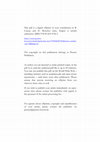
B. Caseau and H. Monchot (eds), Religion et interdits alimentaires, ISBN 978-90-429-4796-2, 2022
Résumé
L’interprétation des restes fauniques de sanctuaires se heurte, en premier lieu, aux nomb... more Résumé
L’interprétation des restes fauniques de sanctuaires se heurte, en premier lieu, aux nombreux problèmes concernant l’aménagement des espaces du temenos. Parmi ceux-ci, citons par exemple, les fréquents remaniement des couches archéologiques, la distinction des dépôts n’est pas toujours établie (e.g., offrandes, dépôts sacrificiels, restes des banquets), les aires de banquets ne sont pas toujours
délimitées, le rite de « thyein » ou consécration par le feu, attestée dans quelques sanctuaires du viiie-vie siècles BC, qui détruit de nombreux ossements. Par ailleurs, la correspondance entre les vestiges archéologiques et les diverses sources textuelles ou iconographiques n’est pas toujours probante. Toutefois les études archéozoologiques, nous ont éclairé sur le choix des espèces choisies, mais
le sexe et l’âge des individus abattus restent sporadiquement identifié à cause d’une intense fragmentation. La présente étude se limite ainsi aux assemblages fauniques des édifices à fonction sacrée d’Oropos en Attique, des sanctuaires d’Hermès et Aphrodite à Symi en Crète, d’Apollon à Soros en Thessalie, de l’édifice K à Minoa (Amorgos) et les autels du double sanctuaire de la ville Haute de Kythnos, dans les Cyclades. Mais peut-on vraiment déchiffrer quelques aspects des rituels anciens ou l’interprétation comportementale ne risque t’elle pas de créer une autre matérialité, à savoir la notre ?
In the first place, the interpretation of the animal remains of the sanctuaries faces many problems concerning especially the spatial organization of the temenos. Among these we will note, for example, the frequent reworking of archaeological layers, the distinction of deposits is not always established (eg, offerings, sacrificial deposits, remains of banquets), the banqueting areas are not always defined, the rite of “thyein” or consecration of fire, attested in some sanctuaries of the 8th-6th centuries BC, which destroys many bones. In addition, the correspondence between the archaeological remains and the various textual or iconographic sources is not always conclusive.
However zooarchaeological studies have enlightened us on the choice of the chosen species, but the sex and the age of the slaughtered individuals remain sporadically identified because of an intense fragmentation. The present study is thus limited to faunal assemblages of sacred buildings of Oropos in Attica, sanctuaries of Hermes and Aphrodite at Symi in Crete, from Apollo at Soros in Thessaly, from the
K building to Minoa (Amorgos) and the altars of the double sanctuary of the Upper Kythnos town in the Cyclades. But can we reallydecipher some aspects of ancient rituals, or doesn’t the behavioral interpretation risks creating another materiality, namely ours?
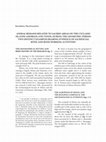
Στο άρθρο παρουσιάζονται τα αρχιτεκτονικά χαρακτηρηστικά του κτηρίου Κ στην ακρόπολη της Μινώας Α... more Στο άρθρο παρουσιάζονται τα αρχιτεκτονικά χαρακτηρηστικά του κτηρίου Κ στην ακρόπολη της Μινώας Αμοργού και του ανδήρου Δ στο Ξώμπουργκο Τήνου.
Ο χώρος που ιδρύθηκε το πρώτο κτίσμα (Κ) χρησιμοποιήθηκε ήδη από την Τελική Νεολιθική. Ο οίκος αυτός δημιουργήθηκε το β’ μισό του 8ου π.Χ. αιώνα και ήταν σε χρήση έως τον 4ο αιώνα μ.Χ. Εξετάζεται η κατανομή των καταλοίπων στο χώρο, η κατάσταση εύρεσης του υλικού, οι ηλικίες σφαγής των ζώων και η επιτόπια διαχείριση του σώματος.
Εξωτερικά του οίκου και του περιβόλου ανασκάφηκαν πυρές με κατάλοιπα κελυφών θαλάσσιων κοχυλιών και οστών από 12 αίγες, τριών προβάτων αλλά και μικρότερων σπονδυλωτών. Αναφορά γίνεται και στους οστέινους πυρήνες κεράτων (πιθανόν) ανάθημα στις θεότητες μετά τον κατά χώρα σφαγιασμό του ζώου.
Στο άνδηρο Δ με τους κτιστούς περιβόλους και τους 32 αβαθείς λάκκους εκτός των καταλοίπων γευμάτων (ταφικών δείπνων;) γεωμετρικής περιόδου, ήρθαν στο φως και απορρίμματα κατεργασίας αυλοειδών οστών (κυρίως μεταποδίων) βοοειδών και ελάφου (παρατίθενται και αρκετά παράλληλα) και μεταποιημένων αστραγάλων.
Τα στρώματα έδωσαν ένα υλικό που με βάση τη συμβατική χρονολόγηση προέρχεται κατά κύριο λόγο απ... more Τα στρώματα έδωσαν ένα υλικό που με βάση τη συμβατική χρονολόγηση προέρχεται κατά κύριο λόγο από τις Προανακτορικές − Παλαιοανακτορικές και Νεοανακτορικές περιόδους (ΜΜ ΙΑ − ΥΜ ΙΒ), ιδιαίτερα από τη Νεοανακτορική περίοδο (ΜΜ ΙΙΙ − ΥΜ Ι), δηλαδή καλύπτουν το χρονικό διάστημα έξι περίπου αιώνων, εστιάζουν όμως σε σχεδόν 150 χρόνια εντατικότερης παρουσίας πιστών. Καθώς όμως η λατρεία και οι θεοί αλλάζουν με τον καιρό, στον λόφο σήμερα λατρεύεται ο Άγιος Γεώργιος. Οι ιδεολογικές αυτές αλλαγές αντικατοπτρίζονται στο αρχαιολογικό περιβάλλον και την ποικιλία των καταλοίπων. Από τα 4703 θραύσματα οστών, που συγκεντρώθηκαν στο ανασκαμμένο τμήμα των ανδήρων 1−7, τουλάχιστον το 41.65% είναι από επιχώσεις με σημαντικό ή πολύ σημαντικό ποσοστό (20−90%) μεταγενέστερης των μινωικών χρόνων κεραμικής.
Archaiologikon Deltion 60, 2005
Archaiologikon Deltion 62, 2007
Αrchaiologikon Deltion 60, 2005
Τα στρώματα έδωσαν ένα υλικό που με βάση τη συμβατική χρονολόγηση προέρχεται κατά κύριο λόγο απ... more Τα στρώματα έδωσαν ένα υλικό που με βάση τη συμβατική χρονολόγηση προέρχεται κατά κύριο λόγο από τις Προανακτορικές − Παλαιοανακτορικές και Νεοανακτορικές περιόδους (ΜΜ ΙΑ − ΥΜ ΙΒ), ιδιαίτερα από τη Νεοανακτορική περίοδο (ΜΜ ΙΙΙ − ΥΜ Ι), δηλαδή καλύπτουν το χρονικό διάστημα έξι περίπου αιώνων, εστιάζουν όμως σε σχεδόν 150 χρόνια εντατικότερης παρουσίας πιστών. Καθώς όμως η λατρεία και οι θεοί αλλάζουν με τον καιρό, στον λόφο σήμερα λατρεύεται ο Άγιος Γεώργιος. Οι ιδεολογικές αυτές αλλαγές αντικατοπτρίζονται στο αρχαιολογικό περιβάλλον και την ποικιλία των καταλοίπων. Από τα 4703 θραύσματα οστών, που συγκεντρώθηκαν στο ανασκαμμένο τμήμα των ανδήρων 1−7, τουλάχιστον το 41.65% είναι από επιχώσεις με σημαντικό ή πολύ σημαντικό ποσοστό (20−90%) μεταγενέστερης των μινωικών χρόνων κεραμικής.
Pleistoc/early Hol., Biodiversity, subsist strat. by Katerina Trantalidou
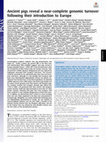
PNAS, 2019
L.A.F. Frantz - J. Haile - A.T. Lin - A. Scheu - C. Geörg - N. Benecke - M. Alexander - A. Linder... more L.A.F. Frantz - J. Haile - A.T. Lin - A. Scheu - C. Geörg - N. Benecke - M. Alexander - A. Linderholm - V.E. Mullin - K.G. Daly - V.M. Battista - M. Price - K.J. Gron - P. Alexandri - R.-M. Arbogast - B. Arbuckle - A. Bălășescu - R. Barnett - L. Bartosiewicz - G. Baryshnikov - Cl. Bonsall - D. Borić - A. Boroneanț - J. Bulatović - C. Çakirlar - J.-M. Carretero - J. Chapman - M. Church - R. Crooijmans - B. De Cupere - Cl. Detry - V. Dimitrijevic - V. Dumitrașcu - L. du Plessis - C. J. Edwards - M. Erek - A. Erim-Özdoğan - A. Ervynck - D. Fulgione - M. Gligor - Α. Götherström - L. Gourichon - M. Groenen - D. Helmer - H. Hongo - L.K. Horwitz - E.K. Irving-Pease - O. Lebrasseur - J. Lesur - C. Malone - N. Manaseryan - A. Marciniak - H. Martlew - M. Mashkour - R. Matthews - G. Motuzaite Matuzeviciute - S. Maziar - E. Meijaard - T. McGovern - H.-J. Megens - R. Miller - A. Mohaseb - J. Orschiedt - D. Orton - A. Papathanasiou - M. Parker Pearson - R. Pinhasi - D. Radmanović - F.-X. Ricaut - M. Richards - R. Sabin - L. Sarti - W. Schier - S. Sheikhi - E. Stephan - J.R. Stewart - S. Stoddart - A. Tagliacozzo - N. Tasić - K. Trantalidou - A. Tresset -C. Valdiosera - Υ. van den Hurk - S. van Poucke - J.-D. Vigne - A. Yanevich - A. Zeeb-Lanz - A. Triantafyllidis - M. Thomas - P. Gilbert - J. Schibler - P. Rowley-Conwy - M. Zeder - J. Peters - T. Cucchi - D.G. Bradley - K. Dobney - J. Burger - A. Evin - L. Girdland-Flink - G. Larson
Archaeological evidence indicates that pig domestication had begun by ∼10,500 y before the present (BP) in the Near East, and mitochondrial DNA (mtDNA) suggests that pigs arrived in Europe alongside farmers ∼8,500 y BP. A few thousand years after the introduction of Near Eastern pigs into Europe, however, their characteristic mtDNA signature disappeared and was replaced by haplotypes associated with European wild boars. This turnover could be accounted for by substantial gene flow from local Euro-pean wild boars, although it is also possible that European wild boars were domesticated independently without any genetic contribution from the Near East. To test these hypotheses, we obtained mtDNA sequences from 2,099 modern and ancient pig samples and 63 nuclear ancient genomes from Near Eastern and European pigs. Our analyses revealed that European domestic pigs dating from 7,100 to 6,000 y BP possessed both Near Eastern and European nuclear ancestry, while later pigs possessed no more than 4% Near Eastern ancestry, indicating that gene flow from European wild boars resulted in a near-complete disappearance of Near East ancestry. In addition, we demonstrate that a variant at a locus encoding black coat color likely originated in the Near East and persisted in European pigs. Altogether, our results indicate that while pigs were not independently domesticated in Europe, the vast majority of human-mediated selection over the past 5,000 y focused on the genomic fraction derived from the European wild boars, and not on the fraction that was selected by early Neolithic farmers over the first 2,500 y of the domestication process. domestication | evolution | gene flow | Neolithic

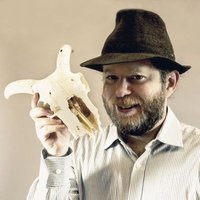

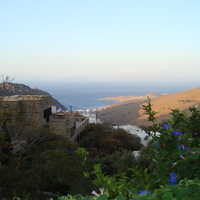
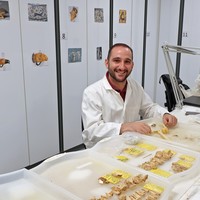






Uploads
Symbolic use of animals, status, belief systems by Katerina Trantalidou
Les documents archéozoologiques, à savoir les 50,000 environ fragments d’os et des coquilles sont, pour la plupart, les restes des pratiques rituels et des événements festifs qui se sont déroulés du VII / VIe siècle au Ie siècle av. J.-C. Les auteurs du texte se sont permis de s’interroger sur certains aspects des rites en se concentrant sur le contexte archéologique, les indices spatiales et temporaires, les espèces animales, la taphonomie et la topologie du corps des animaux domestiques (habituels) et du gibier.
La répartition spatiale révéla que le plus grand nombre des ossements fut concentré autour des autels et dans le dépôt votif. En revanche, les coquillages et les autres matériaux marins furent plus nombreux dans le sékos de l’oikos du sud, dont les sédiments étaient restés intacts, datant du début du VIIe siècle.
La majorité des débris originaires des autels datent de la période hellénistique, la dernière période de l’usage du temenos, mais le dépôt votif, adossé au mur de l’enceinte, comprenait des offrandes écartées d’âge archaïque et classique.
L’examen taphonomique macroscopique du matériel osseux a permis d’évaluer une importante fragmentation et une combustion prolongée des os qui proviennent des couches noircies et grisâtres. La majorité des ossements, provenant du dépôt votif était calcinée, voire craquelés. Dans l’ensemble du temenos, 1% du matériel est resté en entier. En somme, les vestiges représentent divers faits religieux:
1. Dépôts votifs à l’intérieur du sékos. Les offrandes faites à la divinité en demande d'une grâce ou en remerciement d'une grâce obtenue furent multiples (voir le chapitre des petits objets). Parmi eux, 41 astragales (18 provenant de chèvres et 13 de moutons) dont un était aplani et 1735 fragments de coquillages (Tables 1, 3).
2. Dépôts de fondation du temple. Objets votifs et ossements calcinés (Table 1) témoignent que l’opération a été faite au moment du réparation du temple au IIIe siècle av. J.-C.
3. Restes des dîners à l’intérieur du sékos ? Les quelques fragments osseux (restes des chevreaux, lièvres, oiseaux, poissons) et les fruits de mer trouvés à l’intérieur de l’Adyton présupposent la participation directe des divinités en tant que hôtes et dieux vénérés, à côté des plus méritants parmi les humains (les prêtres ?). Peut-on penser à la célébration des Théoxénies ? La présentation des prémices végétales ou marins reste aussi une éventualité plausible.
4. Le point culminant des fêtes, étant le sacrifice, des centaines d’ossements furent collectés autour des autels (Table 2). Le matériel faunique dérive des chèvres. Les os des suidés, bovidés, léporidés, oiseaux et encore moins des poissons sont exceptionnels. Selon la topologie du corps animal les fragments reconnus proviennent de l’humérus, le tibia, les phalanges, les chevilles osseuses et les dents isolées. La zone du sacrum, vertèbres caudales, coxaux, fémurs (absente dans les vases et le sol d’adyton) est rarement présente (table 3). Les modalités sacrificielles ne sont pas connues, mais la présence des chevilles et des phalanges présuppose que tous les étapes du sacrifice, de l’égorgement aux offrandes des parts destinées aux dieux, avaient eu lieu devant les autels.
5. Les animaux intrusives ou sacrées. A l’intérieur d’Adyton et dans la région au sud des autels, les fragments dispersés d’un mustélidé adulte et d’un autre individu respectaient furent collectés .
6. L’immolation des animaux sauvages. Les vestiges découverts dans le temenos proviennent des lièvres. Bien que les animaux sauvages ne sont pas toujours explicitement mentionnés aux sources imagiers et littéraires, certaine espèces furent présentes dans les sanctuaires et probablement consommés.
L’interprétation des restes fauniques de sanctuaires se heurte, en premier lieu, aux nombreux problèmes concernant l’aménagement des espaces du temenos. Parmi ceux-ci, citons par exemple, les fréquents remaniement des couches archéologiques, la distinction des dépôts n’est pas toujours établie (e.g., offrandes, dépôts sacrificiels, restes des banquets), les aires de banquets ne sont pas toujours
délimitées, le rite de « thyein » ou consécration par le feu, attestée dans quelques sanctuaires du viiie-vie siècles BC, qui détruit de nombreux ossements. Par ailleurs, la correspondance entre les vestiges archéologiques et les diverses sources textuelles ou iconographiques n’est pas toujours probante. Toutefois les études archéozoologiques, nous ont éclairé sur le choix des espèces choisies, mais
le sexe et l’âge des individus abattus restent sporadiquement identifié à cause d’une intense fragmentation. La présente étude se limite ainsi aux assemblages fauniques des édifices à fonction sacrée d’Oropos en Attique, des sanctuaires d’Hermès et Aphrodite à Symi en Crète, d’Apollon à Soros en Thessalie, de l’édifice K à Minoa (Amorgos) et les autels du double sanctuaire de la ville Haute de Kythnos, dans les Cyclades. Mais peut-on vraiment déchiffrer quelques aspects des rituels anciens ou l’interprétation comportementale ne risque t’elle pas de créer une autre matérialité, à savoir la notre ?
In the first place, the interpretation of the animal remains of the sanctuaries faces many problems concerning especially the spatial organization of the temenos. Among these we will note, for example, the frequent reworking of archaeological layers, the distinction of deposits is not always established (eg, offerings, sacrificial deposits, remains of banquets), the banqueting areas are not always defined, the rite of “thyein” or consecration of fire, attested in some sanctuaries of the 8th-6th centuries BC, which destroys many bones. In addition, the correspondence between the archaeological remains and the various textual or iconographic sources is not always conclusive.
However zooarchaeological studies have enlightened us on the choice of the chosen species, but the sex and the age of the slaughtered individuals remain sporadically identified because of an intense fragmentation. The present study is thus limited to faunal assemblages of sacred buildings of Oropos in Attica, sanctuaries of Hermes and Aphrodite at Symi in Crete, from Apollo at Soros in Thessaly, from the
K building to Minoa (Amorgos) and the altars of the double sanctuary of the Upper Kythnos town in the Cyclades. But can we reallydecipher some aspects of ancient rituals, or doesn’t the behavioral interpretation risks creating another materiality, namely ours?
Ο χώρος που ιδρύθηκε το πρώτο κτίσμα (Κ) χρησιμοποιήθηκε ήδη από την Τελική Νεολιθική. Ο οίκος αυτός δημιουργήθηκε το β’ μισό του 8ου π.Χ. αιώνα και ήταν σε χρήση έως τον 4ο αιώνα μ.Χ. Εξετάζεται η κατανομή των καταλοίπων στο χώρο, η κατάσταση εύρεσης του υλικού, οι ηλικίες σφαγής των ζώων και η επιτόπια διαχείριση του σώματος.
Εξωτερικά του οίκου και του περιβόλου ανασκάφηκαν πυρές με κατάλοιπα κελυφών θαλάσσιων κοχυλιών και οστών από 12 αίγες, τριών προβάτων αλλά και μικρότερων σπονδυλωτών. Αναφορά γίνεται και στους οστέινους πυρήνες κεράτων (πιθανόν) ανάθημα στις θεότητες μετά τον κατά χώρα σφαγιασμό του ζώου.
Στο άνδηρο Δ με τους κτιστούς περιβόλους και τους 32 αβαθείς λάκκους εκτός των καταλοίπων γευμάτων (ταφικών δείπνων;) γεωμετρικής περιόδου, ήρθαν στο φως και απορρίμματα κατεργασίας αυλοειδών οστών (κυρίως μεταποδίων) βοοειδών και ελάφου (παρατίθενται και αρκετά παράλληλα) και μεταποιημένων αστραγάλων.
Pleistoc/early Hol., Biodiversity, subsist strat. by Katerina Trantalidou
Archaeological evidence indicates that pig domestication had begun by ∼10,500 y before the present (BP) in the Near East, and mitochondrial DNA (mtDNA) suggests that pigs arrived in Europe alongside farmers ∼8,500 y BP. A few thousand years after the introduction of Near Eastern pigs into Europe, however, their characteristic mtDNA signature disappeared and was replaced by haplotypes associated with European wild boars. This turnover could be accounted for by substantial gene flow from local Euro-pean wild boars, although it is also possible that European wild boars were domesticated independently without any genetic contribution from the Near East. To test these hypotheses, we obtained mtDNA sequences from 2,099 modern and ancient pig samples and 63 nuclear ancient genomes from Near Eastern and European pigs. Our analyses revealed that European domestic pigs dating from 7,100 to 6,000 y BP possessed both Near Eastern and European nuclear ancestry, while later pigs possessed no more than 4% Near Eastern ancestry, indicating that gene flow from European wild boars resulted in a near-complete disappearance of Near East ancestry. In addition, we demonstrate that a variant at a locus encoding black coat color likely originated in the Near East and persisted in European pigs. Altogether, our results indicate that while pigs were not independently domesticated in Europe, the vast majority of human-mediated selection over the past 5,000 y focused on the genomic fraction derived from the European wild boars, and not on the fraction that was selected by early Neolithic farmers over the first 2,500 y of the domestication process. domestication | evolution | gene flow | Neolithic
Les documents archéozoologiques, à savoir les 50,000 environ fragments d’os et des coquilles sont, pour la plupart, les restes des pratiques rituels et des événements festifs qui se sont déroulés du VII / VIe siècle au Ie siècle av. J.-C. Les auteurs du texte se sont permis de s’interroger sur certains aspects des rites en se concentrant sur le contexte archéologique, les indices spatiales et temporaires, les espèces animales, la taphonomie et la topologie du corps des animaux domestiques (habituels) et du gibier.
La répartition spatiale révéla que le plus grand nombre des ossements fut concentré autour des autels et dans le dépôt votif. En revanche, les coquillages et les autres matériaux marins furent plus nombreux dans le sékos de l’oikos du sud, dont les sédiments étaient restés intacts, datant du début du VIIe siècle.
La majorité des débris originaires des autels datent de la période hellénistique, la dernière période de l’usage du temenos, mais le dépôt votif, adossé au mur de l’enceinte, comprenait des offrandes écartées d’âge archaïque et classique.
L’examen taphonomique macroscopique du matériel osseux a permis d’évaluer une importante fragmentation et une combustion prolongée des os qui proviennent des couches noircies et grisâtres. La majorité des ossements, provenant du dépôt votif était calcinée, voire craquelés. Dans l’ensemble du temenos, 1% du matériel est resté en entier. En somme, les vestiges représentent divers faits religieux:
1. Dépôts votifs à l’intérieur du sékos. Les offrandes faites à la divinité en demande d'une grâce ou en remerciement d'une grâce obtenue furent multiples (voir le chapitre des petits objets). Parmi eux, 41 astragales (18 provenant de chèvres et 13 de moutons) dont un était aplani et 1735 fragments de coquillages (Tables 1, 3).
2. Dépôts de fondation du temple. Objets votifs et ossements calcinés (Table 1) témoignent que l’opération a été faite au moment du réparation du temple au IIIe siècle av. J.-C.
3. Restes des dîners à l’intérieur du sékos ? Les quelques fragments osseux (restes des chevreaux, lièvres, oiseaux, poissons) et les fruits de mer trouvés à l’intérieur de l’Adyton présupposent la participation directe des divinités en tant que hôtes et dieux vénérés, à côté des plus méritants parmi les humains (les prêtres ?). Peut-on penser à la célébration des Théoxénies ? La présentation des prémices végétales ou marins reste aussi une éventualité plausible.
4. Le point culminant des fêtes, étant le sacrifice, des centaines d’ossements furent collectés autour des autels (Table 2). Le matériel faunique dérive des chèvres. Les os des suidés, bovidés, léporidés, oiseaux et encore moins des poissons sont exceptionnels. Selon la topologie du corps animal les fragments reconnus proviennent de l’humérus, le tibia, les phalanges, les chevilles osseuses et les dents isolées. La zone du sacrum, vertèbres caudales, coxaux, fémurs (absente dans les vases et le sol d’adyton) est rarement présente (table 3). Les modalités sacrificielles ne sont pas connues, mais la présence des chevilles et des phalanges présuppose que tous les étapes du sacrifice, de l’égorgement aux offrandes des parts destinées aux dieux, avaient eu lieu devant les autels.
5. Les animaux intrusives ou sacrées. A l’intérieur d’Adyton et dans la région au sud des autels, les fragments dispersés d’un mustélidé adulte et d’un autre individu respectaient furent collectés .
6. L’immolation des animaux sauvages. Les vestiges découverts dans le temenos proviennent des lièvres. Bien que les animaux sauvages ne sont pas toujours explicitement mentionnés aux sources imagiers et littéraires, certaine espèces furent présentes dans les sanctuaires et probablement consommés.
L’interprétation des restes fauniques de sanctuaires se heurte, en premier lieu, aux nombreux problèmes concernant l’aménagement des espaces du temenos. Parmi ceux-ci, citons par exemple, les fréquents remaniement des couches archéologiques, la distinction des dépôts n’est pas toujours établie (e.g., offrandes, dépôts sacrificiels, restes des banquets), les aires de banquets ne sont pas toujours
délimitées, le rite de « thyein » ou consécration par le feu, attestée dans quelques sanctuaires du viiie-vie siècles BC, qui détruit de nombreux ossements. Par ailleurs, la correspondance entre les vestiges archéologiques et les diverses sources textuelles ou iconographiques n’est pas toujours probante. Toutefois les études archéozoologiques, nous ont éclairé sur le choix des espèces choisies, mais
le sexe et l’âge des individus abattus restent sporadiquement identifié à cause d’une intense fragmentation. La présente étude se limite ainsi aux assemblages fauniques des édifices à fonction sacrée d’Oropos en Attique, des sanctuaires d’Hermès et Aphrodite à Symi en Crète, d’Apollon à Soros en Thessalie, de l’édifice K à Minoa (Amorgos) et les autels du double sanctuaire de la ville Haute de Kythnos, dans les Cyclades. Mais peut-on vraiment déchiffrer quelques aspects des rituels anciens ou l’interprétation comportementale ne risque t’elle pas de créer une autre matérialité, à savoir la notre ?
In the first place, the interpretation of the animal remains of the sanctuaries faces many problems concerning especially the spatial organization of the temenos. Among these we will note, for example, the frequent reworking of archaeological layers, the distinction of deposits is not always established (eg, offerings, sacrificial deposits, remains of banquets), the banqueting areas are not always defined, the rite of “thyein” or consecration of fire, attested in some sanctuaries of the 8th-6th centuries BC, which destroys many bones. In addition, the correspondence between the archaeological remains and the various textual or iconographic sources is not always conclusive.
However zooarchaeological studies have enlightened us on the choice of the chosen species, but the sex and the age of the slaughtered individuals remain sporadically identified because of an intense fragmentation. The present study is thus limited to faunal assemblages of sacred buildings of Oropos in Attica, sanctuaries of Hermes and Aphrodite at Symi in Crete, from Apollo at Soros in Thessaly, from the
K building to Minoa (Amorgos) and the altars of the double sanctuary of the Upper Kythnos town in the Cyclades. But can we reallydecipher some aspects of ancient rituals, or doesn’t the behavioral interpretation risks creating another materiality, namely ours?
Ο χώρος που ιδρύθηκε το πρώτο κτίσμα (Κ) χρησιμοποιήθηκε ήδη από την Τελική Νεολιθική. Ο οίκος αυτός δημιουργήθηκε το β’ μισό του 8ου π.Χ. αιώνα και ήταν σε χρήση έως τον 4ο αιώνα μ.Χ. Εξετάζεται η κατανομή των καταλοίπων στο χώρο, η κατάσταση εύρεσης του υλικού, οι ηλικίες σφαγής των ζώων και η επιτόπια διαχείριση του σώματος.
Εξωτερικά του οίκου και του περιβόλου ανασκάφηκαν πυρές με κατάλοιπα κελυφών θαλάσσιων κοχυλιών και οστών από 12 αίγες, τριών προβάτων αλλά και μικρότερων σπονδυλωτών. Αναφορά γίνεται και στους οστέινους πυρήνες κεράτων (πιθανόν) ανάθημα στις θεότητες μετά τον κατά χώρα σφαγιασμό του ζώου.
Στο άνδηρο Δ με τους κτιστούς περιβόλους και τους 32 αβαθείς λάκκους εκτός των καταλοίπων γευμάτων (ταφικών δείπνων;) γεωμετρικής περιόδου, ήρθαν στο φως και απορρίμματα κατεργασίας αυλοειδών οστών (κυρίως μεταποδίων) βοοειδών και ελάφου (παρατίθενται και αρκετά παράλληλα) και μεταποιημένων αστραγάλων.
Archaeological evidence indicates that pig domestication had begun by ∼10,500 y before the present (BP) in the Near East, and mitochondrial DNA (mtDNA) suggests that pigs arrived in Europe alongside farmers ∼8,500 y BP. A few thousand years after the introduction of Near Eastern pigs into Europe, however, their characteristic mtDNA signature disappeared and was replaced by haplotypes associated with European wild boars. This turnover could be accounted for by substantial gene flow from local Euro-pean wild boars, although it is also possible that European wild boars were domesticated independently without any genetic contribution from the Near East. To test these hypotheses, we obtained mtDNA sequences from 2,099 modern and ancient pig samples and 63 nuclear ancient genomes from Near Eastern and European pigs. Our analyses revealed that European domestic pigs dating from 7,100 to 6,000 y BP possessed both Near Eastern and European nuclear ancestry, while later pigs possessed no more than 4% Near Eastern ancestry, indicating that gene flow from European wild boars resulted in a near-complete disappearance of Near East ancestry. In addition, we demonstrate that a variant at a locus encoding black coat color likely originated in the Near East and persisted in European pigs. Altogether, our results indicate that while pigs were not independently domesticated in Europe, the vast majority of human-mediated selection over the past 5,000 y focused on the genomic fraction derived from the European wild boars, and not on the fraction that was selected by early Neolithic farmers over the first 2,500 y of the domestication process. domestication | evolution | gene flow | Neolithic
The article presents the results of the initial analyzes of archaeological material that came from the excavations in the cave of Kouvaras, Attica and probably concern the 10-9th millennium BC.
Πρόκειται για εκπαιδευτικό Πρόγραμμα που εκπονήθηκε στα τέλη της δεκαετίας του 1990 από το Υπουργείο Παιδείας & Θρησκευμάτων, το Υπουργείο Πολιτισμού και τη Γενική Γραμματεία Λαικής Επιμόρφωσης.
The Sarakenos Cave is located in the eastern part of the basin, at an altitude of 180m, on the relative steep limestone slopes of the Mytikas promontory overlooking the Akraephnion Bay (former Acraephia) landforms, often quoted on several travellers' accounts, scientific reports, journals and corresponding maps conceived between 17th and 19th centuries.
The study conducted on the disposal of (a fraction of) faunal remains in
context (layer, feature, zone, frequencies of inclusions in different fills), allow the assessment that the spatial configuration had a systematic association with the different levels of activity (including regular cleaning of living surfaces and disposal of rubbish under the clay floors, preventing eventually diseases). Distinct spatial units seemed to occur, but mapping will be needed in future horizontal excavations. The main outcome is
that the Sarakenos Cave was used as a (small) human group residential shelter (for "sedentary" behaviour such as solitary social activities, household works and integration among its members), as an animal pen at least for sheep, goats and cows, as an observatory for hunting activities and, periodically, as an area for burying (or exposing,
since not all skeletons were found in connection) dead human bodies
Αναφορά γίνεται στα ζητήματα διαχείρισης των ζώων, στο βιότοπο της περιοχής και συγκρίσεις με οικισμούς της ιδίας περιόδου.
Η σημαντικότερη ανακάλυψη, ωστόσο, ήταν η παρουσία ελάφου Dama dama, γεγονός που ανέτρεψε παλαιότερες απόψεις την περί εισαγωγής του ζώου στη Ρόδο την εποχή των σταυροφόρων. Résumé en français.
The aim is not to examine the conditions and the ideology of each temporal unit, but to understand that the simple, everyday, commonplace practice which we have tried to reconstruct for the place of Akrotiri and the time of the Late Bronze Age, is on the one hand diachronic and on the other a source of inspiration in art and literature.
Στην πλειονότητα των μελετών που είχαν γίνει μέχρι το τέλος της δεκαετίας του 1990 απουσίαζε η διεξοδική περιγραφή η οποία επέτρεπε την ανασύσταση της τεχνικής της σφαγής, της κοπής του ζώου και της βιοτεχνικής χρησιμοποίησής του, κενό που θα μπορούσε να καλυφθεί από την παράλληλη ανάγνωση των φιλολογικών και αρχαιολογικών πηγών.
Τα σημάδια στα οστά ταξινομήθηκαν σε (1) εγκοπές (ίχνη εκδοράς, διαμελισμού) από κοφτερά αντικείμενα (πυριτόλιθο, μαχαίρι, πριόνι, μεγάλο μαχαίρι ή πέλεκυ) (2) ίχνη από θλάση (κρούση) (3) ίχνη από φωτιά και (4) ίχνη από βιοτεχνική επεξεργασία.
Για την ανάγνωση της κίνησης του ανθρωπίνου χεριού χρησιμοποιήθηκαν, κατά κύριο λόγο τα οστά των τεσσάρων αγροτικών ζώων από τη Δυτ. Οικία του αστικού οικισμού της ΥΚ Ι περιόδου Ακρωτηρίου Θήρας.
Γίνονται αναφορές στην άγρια ζωή (μουστελίδες, πτηνά, ιχθύες), στην οικονομία της νήσου του τέλους του 19ου αιώνα (βάσει των διηγήσεων των περιηγητών) και των αρχών του 2οου αιώνα (γεωργική απογραφή 1911) και σε λίγα οστά ανθρώπων.
Τέλος περιγράφονται και σχολιάζονται 10 οστέινα εργαλεία.
This work represents a case study of a larger-scale project whose objective is to establish a marine reservoir correction curve for the entire Aegean Sea region. This curve will have wide application to the dating of archaeological strata throughout the region and will be particularly useful where marine shells are the only datable material for a site. Although the project emphasizes archaeological applications, the results will be of importance also to palaeo-climatic and palaeo-oceanographic studies.
In total 42 samples of terrestrial andmarine origin were collected during two in situ sampling campaigns, in December 2000 and October 2005. During the first campaign 6 samples
were selected and dated at the radiocarbon unit of the laboratory of Archaeometry of NCSR “Demokritos” (Facorellis 1996; Facorellis et al. 1998),whereas during the second one, 36 samples, were dated at the Keck Carbon Cycle AMS facility, University of California at Irvine. The latter set of 36 samples were analyzed for species identification prior to dating (Table 1). The sea shells belonged to the following species: Monodonta turbinata (Von BORN, 1778), Patella
rustica (L., 1758), Patella caerulea (L., 1758), Glycymeris sp., Arca noae (L.,1758), Stramonita haemastoma (L., 1766), Monodonta articulata (LMCK, 1822), Patella ulyssiponensis
(GMELIN, 1791),Hexaplex trunculus (L., 1758) and OperculumBolma rugosa (L., 1767) (Sabelli et al. 1990, SoHelME 2005, Delamotte and Vardala-Theodorou 2007, SoHelFI 2007).
The charcoals belong to the following species: Quercus type evergreen, Olea europaea, cf. Erica sp. and Angiosperm (Schweingruber 1990). The animals bones where fragments from different skeletal parts of Caprinae and one part from Bovidae and stable isotope analyses (δ15N and δ13C: Table 2) indicate that their diet was based on C3 terrestrial plants (Papathanasiou 2000).
The results of the radiocarbon dating are presented in Table 1 and are listed from later to earlier. The conventional radiocarbon ages were converted to calendrical dates based on the international calibration curves IntCal09 for the charcoal samples andMarine09 for the shell samples (Reimer et al. 2009) and using the calibration programCALIB Rev. 6.0.1. (Stuiver and
Reimer 1993). In total 13marine reservoir correction values ΔR (Table 3) were determined. A detailed description of the calculation of the ΔR value can be found in the literature (Stuiver et al. 1986, Stuiver and Braziunas 1993); Facorellis et al. 1998; Facorellis 2011).
Figure 1 shows the fluctuation of ΔR values versus time with a third degree polynomial fit. The variationsmay be due to changes in climate (temperature, freshwater input, etc.) over this period and are probably associated with changes in themovement of sea watermasses in this region of the Aegean. It is worth noting that Skyros lies in the region where the cold, low-salinity sea watermasses coming fromthe Black Sea through the straits of the Hellespont, meet with the warm, high salinitymasses fromthe southern Aegean Sea (Aksu et al. 1995). A more detailed discussion of this variation will be reported elsewhere.
Figure 2 depicts the calibrated calendrical dates in years BC of charcoal samples and animal bones (black bars), and of marine mollusc shells (gray bars) for standard deviations 1σ (closed bars) and 2σ (open bars). These results indicate that Palamari on Skyros was inhabited for about 1200 years (ca 2900-1700 BC), i.e. from PE I till theME II period.
In conclusion, the analysis of samples of terrestrial and marine origin from Palamari has provided information about the plant and animal species used by the residents of the settlement.
The combined absolute dating with the 14C method has allowed firstly the precise determination of the inhabitation, which was found to be between 2900-1700 BC and secondly
the variation of the local ΔR. The variation over this period can now be used for a more accurate and reliable calibration of the conventional radiocarbon dates of marine samples from
the same region and time interval.
The authors wish to thank the archaeologists and directors of the excavation of Palamari site, Mrs. Liana Parlama, Maria Theocharis and Elissavet Chatzipouliou-Kalliri who entrusted
us the study of these samples, as well as the archaeologists, Mrs. Christina Romanou and Mr. Stamatis Bonatsos for providing substantial help and information. We greatly acknowledge the Institute for Aegean Prehistory (INSTAP) and the Curtiss T. & Mary G. Brennan Foundation for funding the first and the second sampling campaigns and samples analyses,
respectively. We also thank Ms. Rachel Moore and Drs. Guarciara dos Santos and Dachun Zhang at the Keck Carbon Cycle AMS facility for their help and stimulating discussions.
The project, which started in 2009, continues with the study of pottery as well as land and sea fauna. Additionally, the study of the metallurgical objects from the site and their metallographic and chemical analyses has provided secure evidence concerning the high level of technological knowledge of copper metallurgy
at Kastro-Palaia from the EBA to the PG period. The pilot study on lead isotope ratios of ores, slag and artefacts shows that the LBA workshop operating on the site had access to metallic tin, supporting the theory that
the LBA workshop was part of a palatial establishment with access to high value commodities. Our data confirm that the workshop had access to a range of metal sources, probably including some of the major copper
sources of the Bronze Age in Jordan/Israel, Bulgaria and either Lavrion or Northern Greece
faunal and plant remains, as well as secondary burials. Although earlier topographical and archaeological studies had located
the site and commented on the presence of archaeological remains, this study represents the fi rst systematic excavation within
two chambers of the cave, presenting detailed discussion of the geology, geomorphology, topography, formation processes, and
archaeology. The paper explores possible functions of the cave in the Bronze Age and its contextual relationship to cult and burial
caves on Crete and mainland Greece, and engages methodological problems of interpreting the evidence of depositional practices
derived from excavation.
Greece. A brief report on selected finds, including lithic tools, bone and shell artefacts and spindle whorls, and their comparative analysis
with objects from another cave site, Piges Anghitis, supports a preliminary interpretation of the function of the cave and its place in
a broader geographical context during the Neolithic period.
Το κείμενο ασχολείται με τη διάταξη του χώρου (ο ωφέλιμος χώρος τους κυμαίνεται μεταξύ 80 και 2400τμ), τις συνθήκες διαμονής, διαβίωσης και προσαρμογής στη μακρά διάρκεια του χρόνου. Συγκεκριμένα συζητούνται: δάπεδα (με επάλειψη πηλού), (λίθινα) υποστρώματα δαπέδων, πασσαλότρυπες, ξερολιθιές, διευθετημένοι χώροι ύπνου και δραστηριότητας, εστίες/πυρές ποικίλων διαμορφώσεων (σε λάκκους ή μη, οριοθετημένες με αργούς λίθους ή μη, φορητές εστίες, διασκορπισμένες στάχτες) και αριθμού (αναλόγως του αριθμού των μελών της ομάδας, της συχνότητας των επισκέψεων, της δυνατότητας επαναχρησιμοποίησης της ίδιας δομής), λάκκοι απορριμμάτων, συσσωρευμένα αλλοιωμένα ή μη υλικά μεταξύ των δαπέδων συζητούνται . Από τα υλικά που έχουν απορριφθεί γίνεται συζήτηση για την κεραμεική, τα λίθινα εργαλεία (συμβολή της κυρίας Μπελεγρίνου και του Δρ. N. Andreasen) και τα διατροφικά κατάλοιπα.
Η μικρομορφολογία (η ανάλυση οργανικής ύλης) και η ζωολογική ανάλυση υποδεικνύουν ότι τα σπήλαια με τα χαρακτηριστικά που αναφέρουμε χρησιμοποιούνται ως ποιμνιοστάσια με περιορισμένη βιοτεχνική δραστηριότητα ενώ σε δύο περιπτώσεις διαπιστώνεται η ύπαρξη χώρου αρμέγματος (στρούγκα).
Παρά τις δυσκολίες στη χρονολογική ένταξη των επιφανειακών ευρημάτων (τα εμπόδια σχετίζονταν με τη μορφή των αγρών τη δεκαετία του 1980, την ποιότητα των κεραμεικών κατηγοριών και την απουσία στρωματογραφικής αλληλουχίας), επισημάνθηκαν 23 και 29 οικισμοί στη Φλώρινα και το Αμύνταιο, με τους περισσότερους να εδράζονται στα ημιορεινά (70%) και στα πεδινά (80%) αντιστοίχως, αριθμοί διδακτικοί για την πυκνότητα της κατοίκησης πέριξ των 4 λιμνών (Πετρών, Βεγορίτιδας, Ζάζαρης και Χειμαδίτιδας).
Οι οικισμοί ήταν επίπεδοι συνήθως όμως χαμηλές τούμπες (<3μ με 3 εξαιρέσεις: <5μ). Η, τότε, εκτίμηση για την έκτασή τους ήταν 10-50 στρέμματα και 4/5-100 στρέμματα αντιστοίχως, ενώ η πλειονότητα των οικισμών φαινόταν (με όλες τις δυνατές επιφυλάξεις) ότι γνώριζε αλλεπάλληλες οικιστικές φάσεις αρχής γενομένης από τη Νεολιθική -συνήθως τη ΝΝ- έως την ΥΕΧ (συχνά οι οικισμοί που κατοικούνταν στην ΥΕΧ επιβίωναν και κατά την ΠΕΣ κι αυτό έμοιαζε να συμβαίνει ιδίως στην περιοχή των λιμνών). Στη Φλώρινα οι αποστάσεις των οικιστικών συγκεντρώσεων σε ευθεία γραμμή ήταν 6-13km, αν και στα ανατολικά κράσπεδα χωροθετούνταν ανά 2km, ενώ στην οικιστική ενότητα του Αμυνταίου σε 1-4km αναλόγως της περιόδου.
Με ένα πρόχειρο απολογισμό, οι δύο πεδιάδες, παρά τη φυσική επικοινωνία των δύο γεωγραφικών ενοτήτων, εμφάνιζαν μεταξύ τους διαφορετικά πολιτισμικά χαρακτηριστικά, τουλάχιστον κατά τη Νεολιθική περίοδο. Επίσης, με βάση τις τότε παρατηρήσεις καταγραφόταν μία δημογραφική αύξηση κατά την ΠΕΧ (ιδίως στη βορειότερη λεκάνη) και αρκετές φορές μία οριστική εγκατάλειψη κατά την ΠΕΣ. Οι οικισμοί μετά την οριστική καταστροφή τους δεν επαναχρησιμοποιήθηκαν εκτός εξαιρέσεων και αυτό στα βυζαντινά χρόνια. Σημειώνεται δηλαδή μετάθεση του οικισμένου χώρου.
Η εργασία αυτή ήταν το πρώτο κεφάλαιο μιας έρευνας που θα μπορούσε να συνεχισθεί με την επιφανειακή συλλογή υλικού, τις ηλεκτρομαγνητικές διασκοπήσεις, την ανασκαφή (όπως και πράγματι συνέβη) και τη συγκριτική μελέτη των τεκμηρίων του υλικού πολιτισμού.
1. (Εικοσι) σπήλαια Νήσου Χάλκης και χρήσεις τους
2. Επιτόπια έρευνα στη δυτική ακτή της Καρπάθου. Ιδιαίτερο βάρος δίνεται σε σπήλαια που λειτούργησαν ως κατοικίες-ποιμνιοστάσια.
3. Αυτοψία στο σπήλαιο της Αρτέμιδος στη Λάρδο Ρόδου (In greek)
The Early Iron Age was an important period of Greek history during which the Greek city states emerged and the two earliest works of western literature, Homer’s Iliad and Odyssey, were likely composed. This paper introduces the results of faunal isotope analyses (carbon and nitrogen) from the settlement of Zagora on Andros (900–700 BC), the first such study to focus on agriculture from the Greek Early Iron Age. Due to limited post-abandonment activity, Zagora provides us with a unique opportunity to investigate agricultural practices at a well-preserved settlement from the period. Amongst our findings we identify possible evidence of specialised cattle management as well as evidence that suggests agriculture may have intensified during the final decades of the settlement’s occupation.
The present phylogeographic pattern of red deer in Eurasia is not only a result of the contraction of their distribution range into glacial refugia and postglacial expansion, but probably also an effect of replacement of some red deer s.l. mtDNA lineages by others during the last 50 000 years. To better recognize this process, we analysed 501 sequences of mtDNA cytochrome b, including 194 ancient and 75 contemporary samples newly obtained for this study. The inclusion of 161 radiocarbon-dated samples enabled us to study the phylogeny in a temporal context and conduct divergence-time estimation and molecular dating. Depending on methodology, our estimate of divergence between Cervus elaphus and Cervus canadensis varied considerably (370 000 or 1.37 million years BP, respectively). The divergence times of genetic lineages and haplogroups corresponded to large environmental changes associated with stadials and interstadials of the Late Pleistocene. Due to the climatic oscillations, the distribution of C. elaphus and C. canadensis fluctuated in north–south and east–west directions. Some haplotypes dated to pre-Last Glacial Maximum periods were not detected afterwards, representing possibly extinct populations. We indicated with a high probability the presence of red deer sensu lato in south-eastern Europe and western Asia during the Last Glacial Maximum.
ancient DNA, Cervus elaphus, cytochrome b, Holocene, Last Glacial Maximum, Late Pleistocene, mtDNA, phylogenetic, phylogeography, postglacial recolonization
Aim: The Expansion-Contraction model has been used to explain the responses of
species to climatic changes. During periods of unfavourable climatic conditions, species
retreat to refugia from where they may later expand. This paper focuses on the
palaeoecology of red deer over the past 54 ka across Europe and the Urals, to reveal
patterns of change in their range and explore the role of environmental conditions in
determining their distribution.
Location: Europe and western Asia to 63°E.
Taxon: Red deer (Cervus elaphus).
Methods: We collected 984 records of radiocarbon-dated red deer subfossils from
the Late Pleistocene and the Holocene, including 93 original dates. For each deer sample
we compiled climatic and biome type data for the corresponding time intervals.
Results: During the last 54 ka changes in red deer range in Europe and the Urals
were asynchronous and differed between western and eastern Europe and western
Asia due to different environmental conditions in those regions. The range of suitable
areas for deer during the Last Glacial Maximum (LGM) was larger than previously
thought and covered vast regions not only in southern but also in western and eastern
Europe. Throughout the period investigated the majority of specimens inhabited
forests in the temperate climatic zone. The contribution of forests in deer localities
significantly decreased during the last 4 ka, due to deforestation of Europe caused by
humans. Mean January temperature was the main limiting factor for species distribution.
Over 90% of the samples were found in areas where mean January temperature
was above −10°C.
Main conclusions: Red deer response to climatic oscillations are in agreement with
the Expansion-Contraction model but in contradiction to the statement of only the
southernmost LGM refugia of the species. During the last 54 ka red deer occurred
mostly in forests of the temperate climatic zone.
K E Y W O R D S
environmental niche modelling, expansion-contraction model, forest habitat, Holocene,
January temperature, Last Glacial Maximum refugia, palaeoecology, radiocarbon dating, temperate climatic zone, ungulates